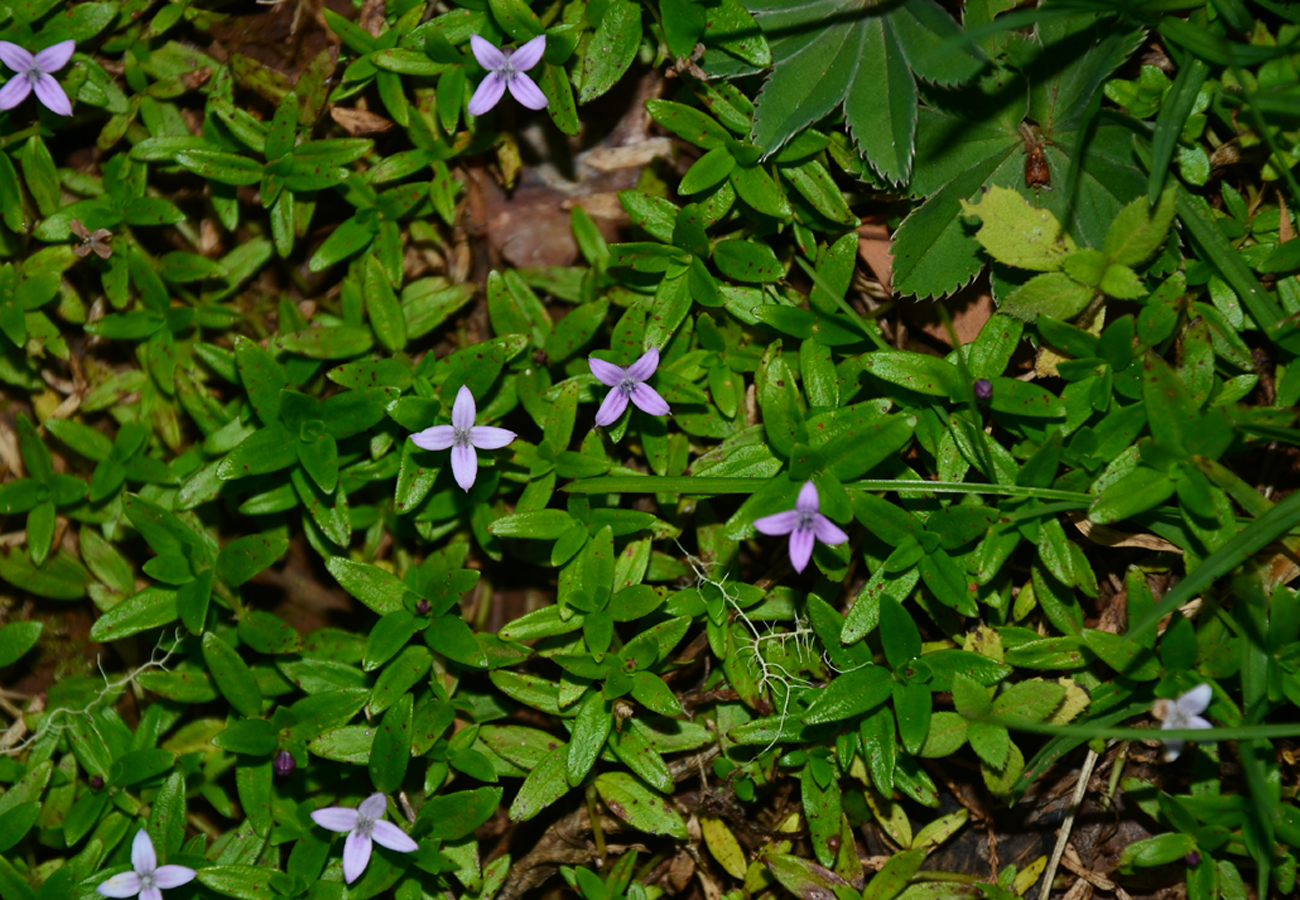Abstract
Oldenlandia violacea (Rubiaceae) was previously treated as a synonym of O. monanthos. However, a detailed examination of the specimens and additional living materials in the field clearly indicated that O. violacea is distinct from O. monanthos in the size of leaves and flowers, and the shape of fruits. The phylogenetic analysis also showed that O. violacea and O. monanthos are nested within Oldenlandia s.str., and could be well separated in the phylogenetic tree. Thus, O. violacea is re-instated here as an independent species.
References
Bremekamp, C.E.B. (1952) The African species of Oldenlandia L. sensu Hiern et K. Schumann. Verhandelingen der Koninklijke Akademie van Wetenschappen, Afdeeling Natuurkunde 48 (2): 1–197.
Groeninckx, I., Dessein, S., Ochoterena, H., Persson, C., Motley, T.J., Kårehed, J., Bremer, B., Huysmans, S. & Smets, E. (2009) Phylogeny of the Herbaceous Tribe Spermacoceae (Rubiaceae) Based on Plastid DNA Data. Annals of the Missouri Botanical Garden 96: 109–132. https://doi.org/10.3417/2006201
Guo, X., Wang, R.J., Simmons, M.P., But, P.P.-H. & Yu, J. (2013) Phylogeny of the Asian Hedyotis-Oldenlandia complex (Spermacoceae, Rubiaceae): Evidence for high levels of polyphyly and the parallel evolution of diplophragmous capsules. Molecular Phylogenetics and Evolution 67: 110–122. https://doi.org/10.1016/j.ympev.2013.01.006
Hiern, W.P. (1877) Rubiaceae. In: Oliver, D. (ed.) Flora of Tropical Africa 3. Crown Agents for Overseas Governments and Administrations, London, 60 & 64 pp.
Hochstetter, C.F.F. & Richard, A. (1847) Rubiaceae. In: Richard, A. (ed.) Tentamen florae Abyssinicae: seu, Enumeratio plantarum hucusque in plerisque Abyssiniae provinciis detectarum et praecipue a beatis doctoribus Richard Quartin Dillon et Antonio Petit (annis 1838–1843) lectarum. Arthus Bertrand, Paris, 359 pp.
Hooker, J.D. (1873) Rubiaeae. In: Bentham, G. & Hooker, J.D. (eds.) Genera Plantarum, vol. 2. Reeve & Co., London, 57 pp.
Jin, J.J., Yu, W.B., Yang, J.B., Song, Y., dePamphilis, C.W., Yi, T.S. & Li, D.Z. (2020) GetOrganelle: a fast and versatile toolkit for accurate de novo assembly of organelle genomes. Genome Biology 21: 241. https://doi.org/10.1186/s13059-020-02154-5
Kårehed, J., Groeninckx, I., Dessein, S., Motley, T.J. & Bremer, B. (2008) The phylogenetic utility of chloroplast and nuclear DNA markers and the phylogeny of the Rubiaceae tribe Spermacoceae. Molecular Phylogenetics and Evolution 49: 843–866. https://doi.org/10.1016/j.ympev.2008.09.025
Lens, F., Groeninckx, I., Smets, E. & Dessein, S. (2009) Woodiness within the Spermacoceae–Knoxieae alliance (Rubiaceae): retention of the basal woody condition in Rubiaceae or recent innovation? Annals of Botany 103: 1049–1064. https://doi.org/10.1093/aob/mcp048
Linnaeus, C. (1753) Species Plantarum, Vol. 1. Stockholm, Salvius, pp. 101, 119 & 172.
Meisner, C.D.F. (1839) Plantarum vascularium genera: secundum ordines naturales digesta eorumque differentiae et affinitates tabulis diagnostacis expositae. Pars I. Libraria Weidmannia, Leipzig, 160 pp.
Miller, M.A., Pfeiffer, W. & Schwartz, T. (2010) Creating the CIPRES Science Gateway for inference of large phylogenetics trees. In: Proceedings of the Gateway Computing Environments Workshop (GCE). LA, New Orleans, pp. 1–8. https://doi.org/10.1109/GCE.2010.5676129
Neupane, S., Dessein, S., Wikström, N., Lewis, P.O., Long, C., Bremer, B. & Motley, T.J. (2015) The Hedyotis-Oldenlandia complex (Rubiaceae: Spermacoceae) in Asia and the Pacific: Phylogeny revisited with new generic delimitations. Taxon 64 (2): 299–322. https://doi.org/10.12705/642.8
Rafinesque, C.S. (1838) New flora and botany of North America. Part 4. Printed for the author and publisher, Philadelphia, 101 pp.
Rambaut, A. & Drummond, A. (2010) TreeAnnotator Version 1.6. 1. University of Edinburgh, Edinburgh.
Rendle, A.B. (1898) New plants from Somali-land. Journal of Botany, British and Foreign 36: 28–31.
Ronquist, F. & Huelsenbeck, J.P. (2003) MrBayes 3: Bayesian phylogenetic inference under mixed models. Bioinformatics 19: 1572–1574. https://doi.org/10.1093/bioinformatics/btg180
Schumann, K.M. (1895) Rubiaceae. In: Engler, A. (Ed.) Die Pflanzenwelt Ost-Afrikas C. Dietrich Reimer, Berlin, 374 pp.
Stamatakis, A. (2006) RAxML-VI-HPC: maximum likelihood-based phylogenetic analyses with thousands of taxa and mixed models. Bioinformatics 22: 2688–2690. https://doi.org/10.1093/bioinformatics/btl446
Verdcourt, B. (1976) Rubiaceae, Part 1. In: Polhill, R.H. (Ed.) Flora of Tropical East Africa. Crown Agents, London, 282 pp.
Wight, R. & Arnott, G.A.W. (1834) Prodromus florae peninsulae Indiae orientalis: containing abridged descriptions of the plants found in the peninsula of British India arranged according to the natural system. Parbury, Allen & Co., London, 406 & 412 pp. https://doi.org/10.5962/bhl.title.252
Wikström, N., Neupane, S., Kårehed, J., Motley, T.J. & Bremer, B. (2013) Phylogeny of Hedyotis L. (Rubiaceae: Spermacoceae): Redefining a complex Asian-Pacific assemblage. Taxon 62: 357–374. https://doi.org/10.12705/622.2
Zeng, C.X., Hollingsworth, P.M., Yang, J., He, Z.S., Zhang, Z.R., Li, D.Z. & Yang, J.B. (2018) Genome skimming herbar-ium specimens for DNA barcoding and phylogenomics. Plant Methods 14: 43. https://doi.org/10.1186/s13007-018-0300-0


